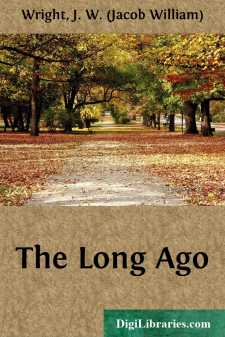Categories
- Antiques & Collectibles 13
- Architecture 36
- Art 48
- Bibles 22
- Biography & Autobiography 813
- Body, Mind & Spirit 142
- Business & Economics 28
- Children's Books 14
- Children's Fiction 11
- Computers 4
- Cooking 94
- Crafts & Hobbies 4
- Drama 346
- Education 46
- Family & Relationships 57
- Fiction 11829
- Games 19
- Gardening 17
- Health & Fitness 34
- History 1377
- House & Home 1
- Humor 147
- Juvenile Fiction 1873
- Juvenile Nonfiction 202
- Language Arts & Disciplines 88
- Law 16
- Literary Collections 686
- Literary Criticism 179
- Mathematics 13
- Medical 41
- Music 40
- Nature 179
- Non-Classifiable 1768
- Performing Arts 7
- Periodicals 1453
- Philosophy 64
- Photography 2
- Poetry 896
- Political Science 203
- Psychology 42
- Reference 154
- Religion 513
- Science 126
- Self-Help 84
- Social Science 81
- Sports & Recreation 34
- Study Aids 3
- Technology & Engineering 59
- Transportation 23
- Travel 463
- True Crime 29
The Long Ago
Description:
Excerpt
The day is done, and yet we linger here at the window of the private office, alone, in the early evening. Street sounds come surging up to us—the hoarse Voice of the City—a confused blur of noise—clanging trolley-cars, rumbling wagons, and familiar cries—all the varied commotion of the home-going hour when the city's buildings are pouring forth their human tide of laborers into the clogged arteries.
We lean against the window-frame, looking across and beyond the myriad roofs, and listening. The world-weariness has touched our temples with gray, and the heaviness of the day's concerns and tumult presses in, presses in .... presses in ....
Yet as we look into the gentle twilight, the throbbing street below slowly changes to a winding country road .... the tall buildings fade in the sunset glow until they become only huge elm-trees overtopping a dusty lane .... the trolley-bells are softened so that they are but the distant tinkle of the homeward herd on the hills .... and you and I in matchless freedom are once more trudging the Old Dear Road side by side, answering the call of the wondrous Voice of Boyhood sounding through the years.
The Garden
It was the spirit of the garden that crept into my boy-heart and left its fragrance, to endure through the years. What the garden stood for—what it expressed—left a mysterious but certain impress. Grandmother's touch hallowed it and made it a thing apart, and the rare soul of her seemed to be reflected in the Lilies of the Valley that bloomed sweetly year by year in the shady plot under her favorite window in the sitting-room. Because the garden was her special province, it expressed her own sturdy, kindly nature. Little wonder, then, that we cherished it; that I loved to roam idly there feeling the enfoldment of that same protection and loving-kindness which drew me to the shelter of her gingham-aproned lap when the griefs of Boyhood pressed too hard upon me; and that we walked in it so contentedly in the cool of the evening, after the Four O'clocks had folded their purple petals for the night.
Grandmother's garden, like all real gardens, wasn't just flowers and fragrance.
There was a brick walk leading from the front gate to the sitting-room entrance—red brick, all moss-grown, and with the tiny weeds and grasses pushing up between the bricks. In the garden proper the paths were of earth, bordered and well-defined by inch-wide boards that provided jolly tight-rope practice until grandmother came anxiously out with her oft-repeated: "Willie don't walk on those boards; you'll, break them down." And just after the warm spring showers these earthwalks always held tiny mud-puddles where the rain-bleached worms congregated until the robins came that way.
There's something distinctive and individual about the paths in a garden—they either "belong," or they do not. Imagine cement walks in grandmother's garden! Its walks are as much to a garden as its flowers or its birds or its beetles, and express that dear, indescribable intimacy that makes the Phlox a friend and the Johnny-Jump-Up a play-fellow.
The best place for angle-worms was underneath the white Syringa bush—the tallest bloomer in the garden except the great Red Rose that climbed over the entire wall of the house, tacked to it by strips of red flannel, and whose blossoms were annually counted and reported to the weekly newspaper.
Another good place was under the Snowball bush, where the ground was covered with white petals dropped from the countless blossom-balls that made passers-by stop in admiration....


